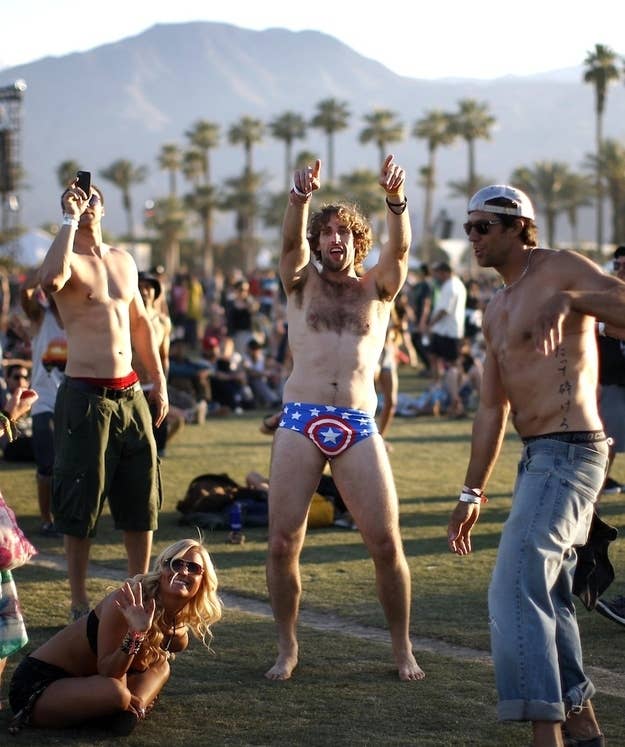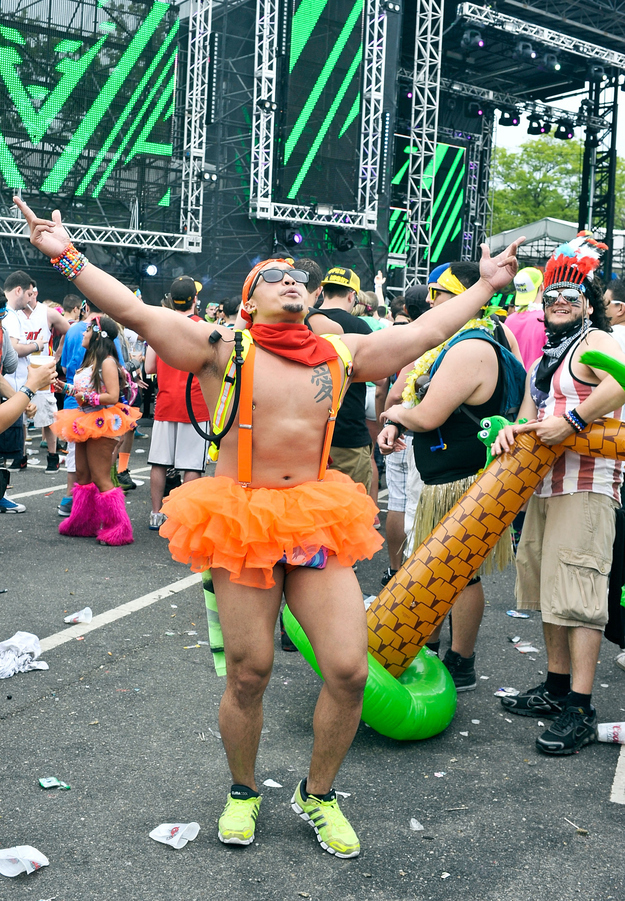
Jim Tremayne has been going to raves for more than two decades. It's part of his job as the editor of the country's top electronic dance music (EDM) magazine, DJ Times, but his work can get a bit uncomfortable.
"I feel like the creepy uncle sometimes when I'm working a show," said Tremayne, who often finds himself at concerts before "a gaggle of girls — I don't know, they're 19 years old or something, and they're wearing very little." Think: underwear. At most, "they might have some sort of fluffy legwear going on."
EDM festivals — or raves — have become events welcoming increasing nakedness as they've attained mainstream popularity. Women and men now routinely strip down to flashy and alarmingly skimpy outfits to attend festivals like Coachella, Electric Daisy, and Electric Zoo — a dramatic shift from how the rave scene began. "In the '90s there was sort of an asexual vibe to raverwear," Tremayne said. "The big, baggy stuff didn't really accentuate any hips or boobs or anything, whereas now it's so in your face."
EDM developed a cult following in the '80s. Since the music wasn't played on the radio, fans had to seek it out — and not just by going to record shops, but by using physical maps to navigate themselves to raves, where they could hear the music live in hidden locations that only the most dedicated fans would bother discovering. And they dressed more like they were going camping than to a Vegas pool party — flannels and enormous pants and polo shirts were cool. Baggy was THE rave look. But now that the genre has exploded in popularity, that's all changed. Spending the days or weeks leading up to EDM festivals bedazzling bras and DIY-ing bikini bottoms if you're a woman, or simply picking up a Speedo and oversized flag to wear as a cape if you're a man, is a normal part of the festival experience for millennials.
The result: Good luck finding anyone who showed up to the Calvin Harris set wearing Dad's flannel.
In the '90s, rave culture was "proudly and happily underground," Tremayne said. But that's all changed thanks to social media. At shows, "I'll notice all people are doing are taking pictures or Instagramming crazy things, and it's not necessarily about the music — it's about, 'Look at me, I'm justifying my existence by putting up my Facebook status,'" he continued. "It's about, 'Look at me and my friends going out, look how much fun we're having, look at what we're wearing, look at that crazy guy over there.'" Plugging EDM into social media turned its festivals into the biggest, most shareable party of our time — and kids are dressing to get noticed in the millions of bits of EDM festival content that positively floods social networks.
Edc bra finished! ❤💋

Shannon Brennan
@ShannonBrennan7
Edc bra finished! â¤ðŸ’‹

L.A.-based DJ Reid Speed frequently sees people at EDM shows wearing nipple tape in place of tops, underwear in place of clothes, and candy in place accessories you can't eat. "It's like the prosti-tot trend has taken over," she said. "Even the guys, if they're wearing a shirt — halfway through the party they're not wearing it anymore."
"Culture has just become extremely sexually charged in a way that, before the internet, wasn't a thing," she continued. "While you wanna believe that women are just becoming empowered and feel comfortable with their bodies, I'm not sure that's what it's all about." (She also acknowledged that men are equal opportunists when it comes to near nudity at these things.)
Reid noticed a shift in rave fashion around 2004 or 2005, when concert promoters started advertising "pajama" or "lingerie" parties to lure people to raves, which drew a lot of kids out in their underwear. At the time, raves were experiencing a bit of a lull, but the pajama parties really took off. "They were having them in Seattle and Denver and places that were cold, and you're like, wait — it's cold!" recalled Reid. "I can understand in Southern California why people would want to take their clothes off, but when you see 14-year-old girls shivering in a snowstorm in Denver, you're like, this is just sad."
Reid also suspects the heavily male DJ scene — and the vast majority of DJs at every major festival are men — also exerts some influence over the fashion (or lack thereof) at raves now. Acts like Borgore, whose tracks include "Act Like a Ho" and "Nympho," are known for sexually charged music. "He's really funny. It's like an act, but his act is to sell misogyny, and people love it. They eat it up. They go to his shows and hope they can have sex with him," Reid says. "If there were a lot more positive female role models, the culture would probably change, and you'd see the fashion change along with it because girls would be like, fuck that — I don't need to slut it up to get noticed at a party."
Reid describes herself as "not a sexy female DJ — you're not going to see sexy bikini pictures on the internet." Yet she's felt pressure, like any female performer these days, to sexualize her image. She even turned down repeated requests to pose for Playboy — a lucrative offer, but not one she regrets passing up. "I'm not going to tell girls [at concerts] they look stupid," she said. "It's just sad that girls don't care more about just trying look good for themselves — they're so wanting to be thought of as a desirable sex object by boys on drugs. If I can help change that mind-set, that would be awesome."
Billboard contributor Kerri Mason, who specializes in EDM, sees skimpy raver fashion as merely another facet of sexualized images of young female celebrities that the world has simply become accustomed to. Since the late '90s, Britney Spears became a teen sex symbol, Paris Hilton came and went, and the likewise figure-flaunting Kardashians rose to astounding levels of popularity. The covered style of grunge also ended (though it's now chipping away at a runway comeback, it's not yet gaining significant traction on the streets). Skimpy clothing is simply normal for young, concertgoing girls.
"I think when women...allow themselves to be more playful with how they dress, there's a backlash," said Mason, noting that the nearly naked look has been co-opted by men at these festivals too. "I was walking past guys at [Electric Daisy Carnival] in New York wearing no shirts, and I'm like, they must have worked out for months for this." The way she sees it: "All the dudes look like go-go boys from Splash."

But where some see conformism, Mason sees empowerment — and just plain fun. "When you see girls at these festivals, and they're wearing next to nothing they are owning next to nothing. They're not doing it for the male gaze. They're doing it because they want to — they're super comfortable walking around like that, they're not overly self-conscious, they're really free. And normally [they're] in packs of their friends that are kind of protective," she says. "So maybe it's just a really free space for that kind of impression."
